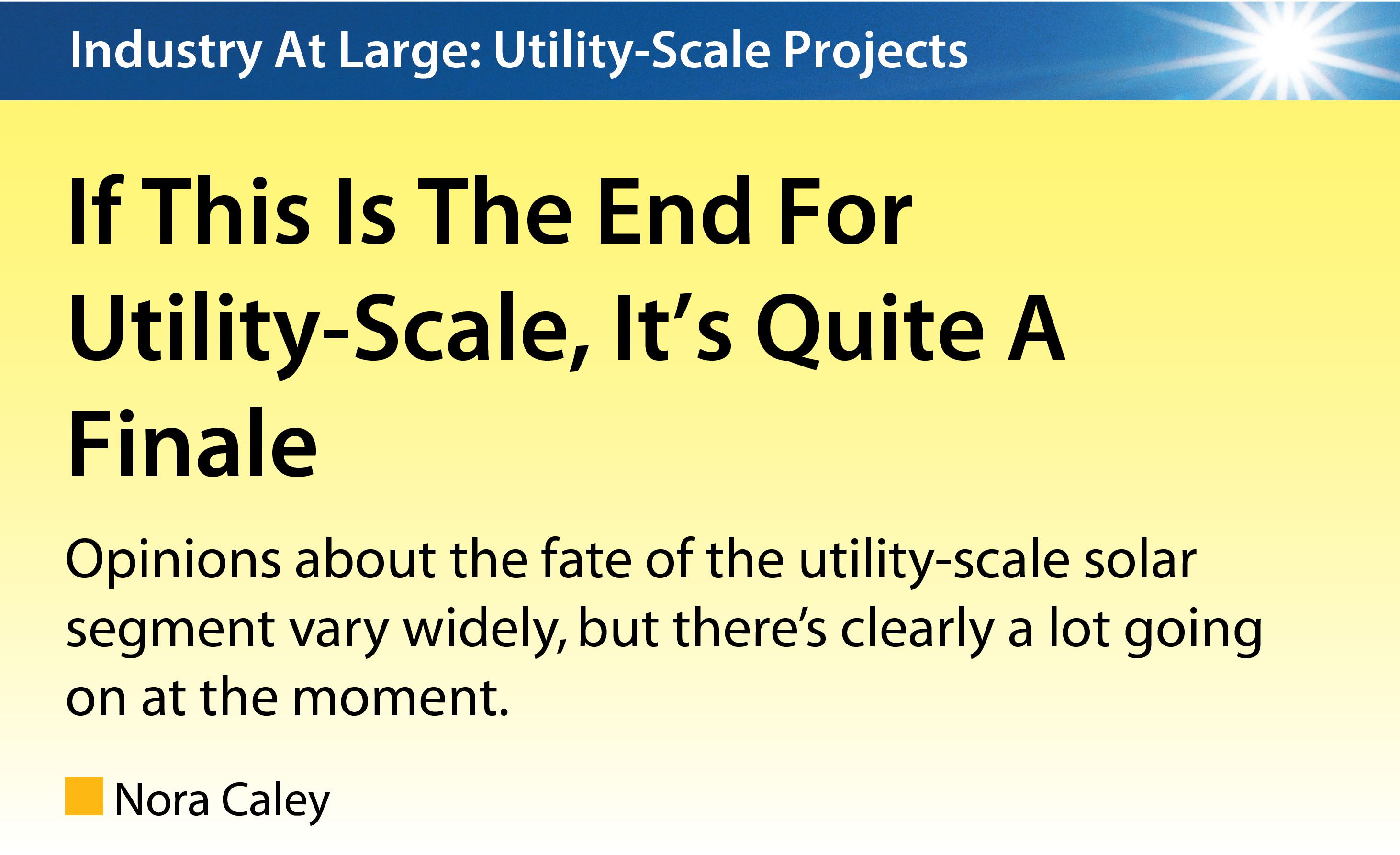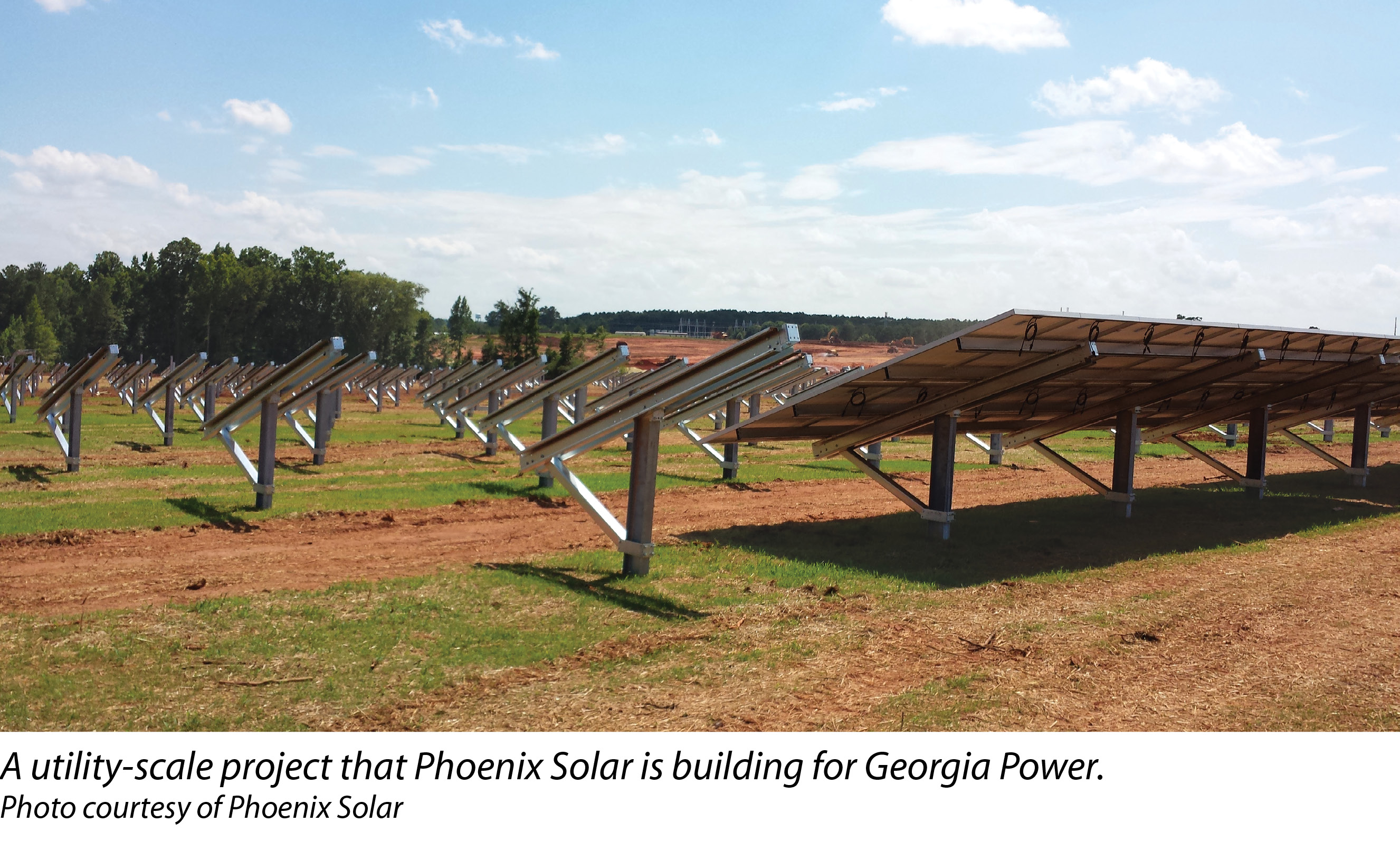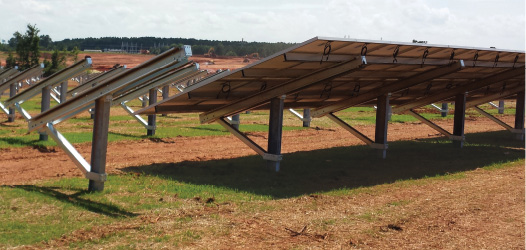

301 Moved Permanently
The utility-scale solar segment is not what it used to be. Developers announce enormous projects, then never begin construction or quietly stop building. Many states are on track to fulfill their renewable portfolio standards (RPS), so they are not entering into many more power purchase agreements (PPAs). Financing is difficult, so developers are switching to distributed-generation (DG) models.
If the utility-scale market is, indeed, fading in the U.S. - as some solar watchers suggest - then the business is making a spectacular exit. Although there will likely be fewer ground-breaking ceremonies for hundreds-of-megawatts photovoltaic installations, there are still so many projects under construction that the utility market remains strong.
According to “U.S. Solar Market Insight: 1st Quarter 2013,” a report by GTM Research and the Solar Energy Industries Association (SEIA), the U.S. installed 723 MW of PV in the first quarter 2013, which accounted for more than 48% of all new electric capacity installed in the U.S. during that quarter. The utility market segment registered a first-quarter high of 318 MW. Also, the utility market more than doubled year over year, with 24 utility PV projects completed in first quarter 2013.
The segment is healthy, says Rhone Resch, president and CEO of SEIA. He points to various large projects that are under construction. The 250 MW California Valley Solar Ranch, in eastern San Luis Obispo County, has 22 MW on the grid and is scheduled to be completed in October. The project, which NRG Solar acquired from SunPower Corp., has a PPA with Pacific Gas & Electric Co. (PG&E). Also in California, First Solar is constructing the Desert Sunlight Solar Farm in Riverside County, a 550 MW project with a PPA with PG&E and Southern California Edison (SCE), for a 2015 completion. First Solar is also building the 250 MW Agua Caliente Solar Project in Yuma County, Ariz., also with a PPA with PG&E.
“These projects come online fairly quickly,” Resch says. “Eventually, the announcements will slow, and construction will decrease. With respect to the long-term growth, utilities are still putting out [requests for proposals] but not as much as before.”
Utilities are not issuing as many requests for proposals these days because, quite simply, some states are solidly on track to fulfill their RPS. For example, according to the California Public Utilities Commission’s website, the state’s three investor-owned utilities - PG&E, SCE and San Diego Gas and Electric - collectively served 19.8% of their 2012 retail electricity sales with renewable power. California’s RPS is 33% by 2020.
Still building
That does not spell the end to utility-scale projects. Some states might increase their RPS because a higher RPS means more construction. “They see construction as job creation, and they see solar and wind actually saving money for ratepayers,” Resch says.
Kevin Sagara, vice president of renewables for San Diego-based Sempra U.S. Gas & Power, says utility-scale solar is evolving. “We have seen many more developers enter the space, as well as large price declines that have been very beneficial to end users,” he says. “Photovoltaic products and their efficiencies also continue to improve, as well as design and construction techniques.”
The company recently completed the 92 MW first phase of Copper Mountain Solar 2 in Boulder City, Nev., with the remaining 58 MW scheduled to complete construction in 2015. Sempra is also constructing the 250 MW Copper Mountain Solar 3 for completion in 2015. The projects have a PPA with PG&E.

Sagara adds that renewable portfolio standards have been the biggest driver of utility solar installations. “We’re cautiously optimistic we will see these standards continue to be raised across the country,” he says.
Incentives such as the investment tax credit (ITC) have also helped. “We’re hopeful creative structures that are being discussed, such as renewable MLPs, will continue to gain support,” Sagara says.
MLPs, or master limited partnerships, are an investment tool used widely in the oil and gas industry. Earlier this year, U.S. senators introduced the MLP Parity Act to make MLPs available for renewable energy.
The ITC is the reason for the construction boom, says Matt Feinstein, an analyst with Boston-based Lux Research. Utility-scale projects are still going up in the U.S. because the credit will remain at 30% until December 31, 2016. After that, it reduces to 10%.
“Big projects will start construction in 2016 to capture the credit,” he says. “We will see more go online as projects are finished. After that, we will stop seeing these hundreds-of-megawatts projects. They will cease to exist.”
Lux Research recently released its report, “Market Size Update 2013: Return to Equilibrium,” which indicated that the solar PV market is poised to grow to $155 billion in 2018, with a compound annual growth rate of 10.5%.
Most of that growth will occur in emerging markets, Feinstein says. In the U.S., part of the challenge is that the larger projects are hard to finance. “Developers should get ready to build smaller projects,” he says.
In the meantime, according to SEIA, the pipeline of utility projects with PPAs signed but which are not yet in operation totals 10.7 GW, of which 3.9 GW are under construction. “While it’s likely that many of the announced projects will never be completed, the future still looks good for large-scale solar in the U.S., in terms of overall capacity,” says Mark Goodreau, director of utility-scale solar solutions for Lawrence, Mass.-based inverter manufacturer Solectria Renewables.
Goodreau agrees that smaller projects will be the norm. “We see more developers now focusing on smaller-scale utility projects, 5 MW to 20 MW in size. These projects are faster and less risky to develop, with simpler interconnection and permitting processes. Small utility-scale projects are also a better fit in states without a lot of open land suitable for ground-mount arrays,” he says.
States that do have copious open land include six western states with vast public lands. In October, President Obama and then-Secretary of the Interior Ken Salazar announced a Bureau of Land Management (BLM) program to spur development of solar energy on public lands in Arizona, California, Colorado, Nevada, New Mexico and Utah. The Programmatic Environmental Impact Statement for solar energy development will help make permitting easier by establishing solar energy zones with access to existing or planned transmission, incentives for development within those zones and a process to consider additional zones and solar projects.
Shannon Eddy, executive director of the Sacramento, Calif.-based Large-Scale Solar Association, says the 280,000 acres the BLM set aside for solar is still many millions of acres less than what has long been set aside for oil and gas. Still, there are reasons to remain optimistic about large-scale solar.
“We are starting to see a lot of the projects coming online in the next couple of years,” she says. “Utility projects are here to stay. They are the future.”
Eddy notes that there will still be a need for utility-scale projects because solar has many advantages. “Solar has a fixed price,” she says. “We know natural gas prices will go up. Solar is a fantastic hedge to shelter ratepayers from the rising prices of natural gas.”
However, Roberta Gamble, partner with Mountain View, Calif.-based Frost & Sullivan, says natural gas might not help the solar cause. “The price of natural gas has stayed low, thanks to the growing shale gas market in the U.S., which makes solar power seem more expensive in comparison to conventional power,” says Gamble, who is also the head of the Energy and Environment practice for North America for the consulting company. “Utilities that need to meet a renewable goal can usually turn to wind power or other alternatives that tend to be less expensive than solar, despite the falling prices.”
Also, utilities are turning to consumer incentives, smart thermostats and grid modernization instead of adding power generation, Gamble says. Still, there are opportunities.
“The market for solar overall is still quite healthy, thanks to falling prices in the last few years and good incentives for installations. However, most of this market has been with homeowners and businesses, not utilities,” she says.
Utilities adapt
Some utilities are finding other solutions. “Regulated utilities are watching the development of the solar market very closely,” says Mike Hall, CEO of solar installer Borrego Solar Systems Inc., headquartered in San Diego.
“We see a lot of companies that own regulated utilities being aggressive about participating in both utility-scale and DG solar through their unregulated power companies,” he remarks. “We also see that utilities are increasingly concerned about what the penetration of large amounts of solar means for the grid.”
Consumers are interested in solar, and that has helped shift the attention to DG projects of less than 20 MW, says Aaron Thurlow, vice president of sales and marketing for Fremont, Calif.-based module manufacturer Silevo Inc.
“Consumers have adopted and support solar, and the recent cost declines and technology improvements in solar, along with a resurgence in the fight against climate change, will be driving forces in continued growth,” Thurlow says. “Climate change policy will continue to be a driving force at the state level, especially on the coasts in California and New York.”
Some developers are finding opportunities in states that do not have an RPS. Phoenix Solar Inc., with U.S. headquarters in San Ramon, Calif., announced it signed an agreement with Silicon Ranch Corp. to build the 38.6 MW Simon Solar Farm in Georgia, with a PPA with Georgia Power.
Simon Decker, business development and marketing manager for the U.S. at Phoenix Solar, says that is the right size now for a utility-scale project. “We still might see, here and there, plans for very large systems over 200 MW,” he says. “However, the larger it gets, the lengthier the development process becomes. This translates into a higher development and financing risk.”
There are opportunities, though, as more utilities become interested in solar. “There are smaller utilities or municipalities in the country that are interested in renewable energy programs, but they have no experience in creating programs, or they have technical concerns in regards to grid integration,” Decker says.
The segment is not going away, says Resch of SEIA. “The question is, are we going to continue building large utility-scale plants? And I think the answer is yes.” S
Industry At Large: Utility-Scale Projects
If This Is The End For Utility-Scale, It’s Quite A Finale
By Nora Caley
Opinions about the fate of the utility-scale solar segment vary widely, but there’s clearly a lot going on at the moment.


si body si body i si body bi si body b
si depbio
- si bullets
si sh
si subhead
pullquote
si first graph
si sh no rule
si last graph